
The Marasmiaceae are a family of fungi in the order Agaricales. Basidiocarps are most frequently agarics, but occasionally cyphelloid. According to a 2008 estimate, the family contained 54 genera and 1590 species, but molecular research, based on cladistic analysis of DNA sequences, has led to a more restricted family concept, so that the Marasmiaceae included just 13 genera, and some 1205 species. It was reduced further down in 2020, to 10 genera and about 700 species.

The Tricholomataceae are a large family of fungi within the order Agaricales. Originally a classic "wastebasket taxon", the family included any white-, yellow-, or pink-spored genera in the Agaricales not already classified as belonging to e.g. the Amanitaceae, Lepiotaceae, Hygrophoraceae, Pluteaceae, or Entolomataceae.

Gerronema is a genus of small- to medium-sized lignicolous agarics with white, nonamyloid, spores and decurrent gills. The genus was circumscribed by American mycologist Rolf Singer in 1951.
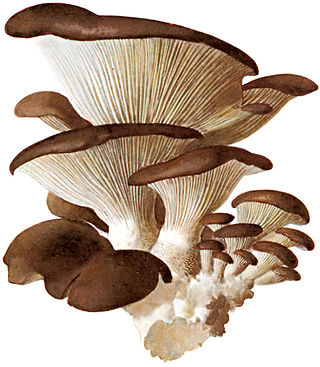
The Pleurotaceae are a family of small to medium-sized mushrooms which have white spores. The family contains 13 genera over 412 species. Members of Pleurotaceae can be mistaken for members of Marasmiaceae. Perhaps the best known member is the oyster mushroom, Pleurotus ostreatus.

Collybia is a genus of mushrooms in the family Tricholomataceae. The genus has a widespread but rare distribution in northern temperate areas, and contains three species that grow on the decomposing remains of other mushrooms.
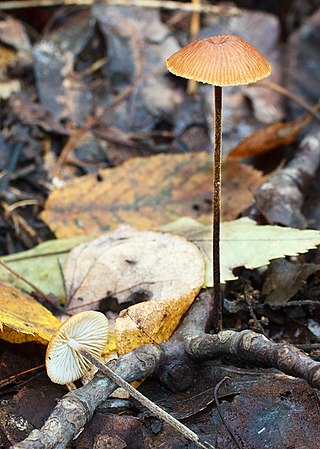
Rhizomarasmius is a genus of fungi in the family Physalacriaceae, containing about five species.
Termiticola is a fungal genus in the family Agaricaceae. It is a monotypic genus, containing the single species Termiticola rubescens, found in Papua New Guinea.

Anthracophyllum is a genus of fungi in the family Omphalotaceae in the order Agaricales. The genus is widespread in tropical regions, and contains 10 species.
Aphyllotus is a fungal genus in the family Marasmiaceae. This is a monotypic genus, containing the single species Aphyllotus campanelliformis, found in Colombia. Both the species and the genus were described by mycologist Rolf Singer in 1973.
Cephaloscypha is a fungal genus in the family Marasmiaceae. This is a monotypic genus, containing the single species Cephaloscypha morlichensis. The genus and species were described by mycologist Reinhard Agerer in 1975.

Clitocybula is a genus of mushroom-forming fungi in the family Porotheleaceae but was originally classified within Marasmiaceae. The genus was circumscribed by Georges Métrod in 1952. Species in the genus are commonly known as "coincaps".
Deigloria is a genus of agaric fungus in the family Marasmiaceae. Described by mycologist Reinhard Agerer in 1980, the genus contains 10 species that are widespread in neotropical areas. The generic name derives from the Latin words Deus (God) and gloria (glory).
Epicnaphus is a genus of mushroom-forming fungi in the family Marasmiaceae. The genus, circumscribed by mycologist Rolf Singer in 1960, contains two species found in South America. Fruitbodies of Epicnaphus species are similar in appearance to those in Marasmius section Sicci, but have a smooth hymenium and broom cells of the Rotalis-type. Singer initially included only the type species, E. phalaropus, which was originally collected from fallen branches in a Bolivian rainforest. The Argentinian species E. longispora was added to the genus by Jörg Raithelhuber in 1973.

Henningsomyces is a genus of fungi in the family Marasmiaceae.
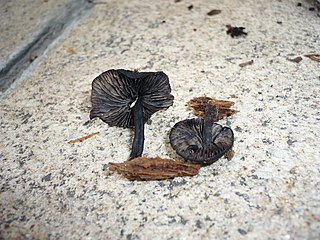
Hydropus is a genus of fungi in the family Marasmiaceae. The widespread genus contains about 100 species, especially in tropical areas, but is not well represented in temperate regions. About 15 taxa are found in Europe; H. floccipus has the widest distribution in western Europe. Hydropus was circumscribed by Rolf Singer in 1948. Species in the genus have fruit bodies with caps that are mycenoid, collybioid, or omphaloid in form. Most species occur in tropical and subtropical regions, where they grow as saprobes on rotting wood, forest litter, and mosses. Generally, most Hydropus species are rare, and several are known only from the type collection, including H. conicus, H. moserianus, H. nitens, and H. paradoxus.
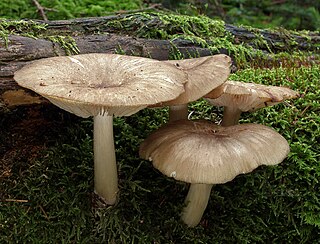
Megacollybia is a genus of fungus in the family Marasmiaceae. Previously thought to be monotypic, the genus was split into several species on the basis of genetic data in 2007. The type species, M. platyphylla, is restricted in distribution to Europe, Scandinavia, and western and central Russia. M. rimosa was described as new to science from Brazil in 2013.
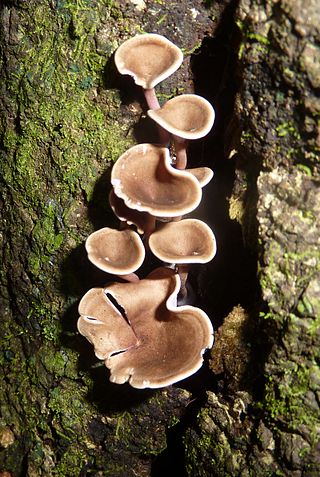
Trogia is a genus of fungi in the family Marasmiaceae. It is named after a Swiss mycologist Jacob Gabriel Trog. The genus contains about 20 species that are widely distributed in tropical areas.
Semiomphalina is a basidiolichen genus in the family Hygrophoraceae. The genus is monotypic, containing the single species Semiomphalina leptoglossoides, found in Papua New Guinea.











